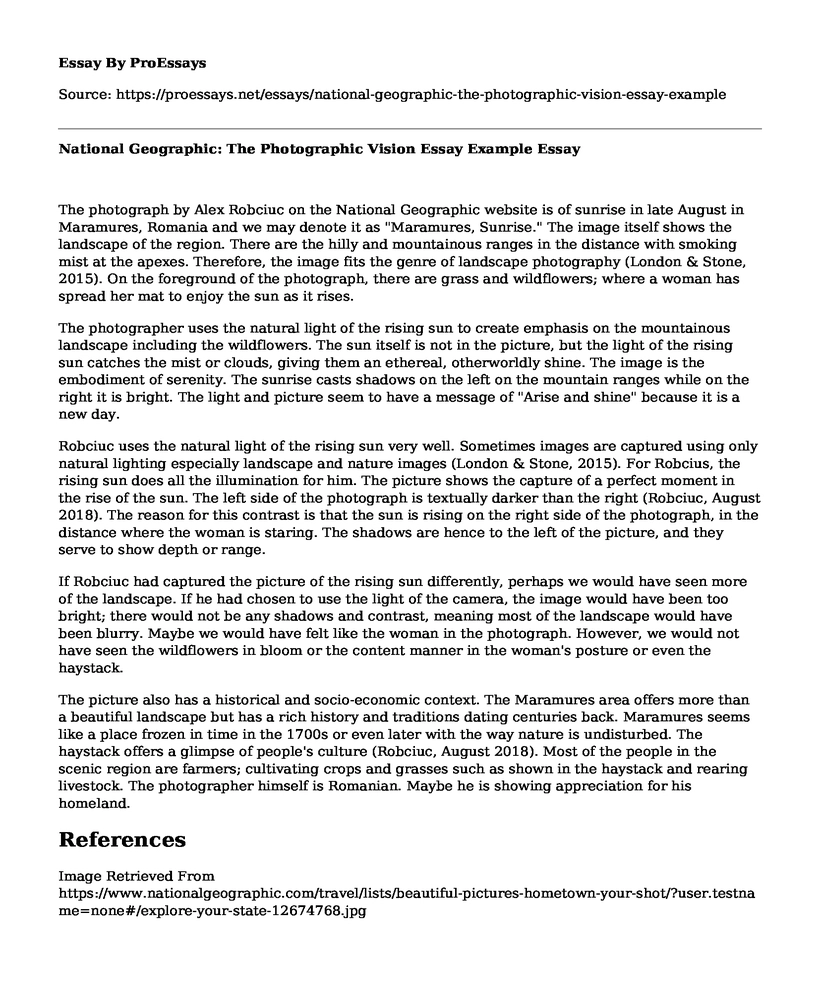The photograph by Alex Robciuc on the National Geographic website is of sunrise in late August in Maramures, Romania and we may denote it as "Maramures, Sunrise." The image itself shows the landscape of the region. There are the hilly and mountainous ranges in the distance with smoking mist at the apexes. Therefore, the image fits the genre of landscape photography (London & Stone, 2015). On the foreground of the photograph, there are grass and wildflowers; where a woman has spread her mat to enjoy the sun as it rises.
The photographer uses the natural light of the rising sun to create emphasis on the mountainous landscape including the wildflowers. The sun itself is not in the picture, but the light of the rising sun catches the mist or clouds, giving them an ethereal, otherworldly shine. The image is the embodiment of serenity. The sunrise casts shadows on the left on the mountain ranges while on the right it is bright. The light and picture seem to have a message of "Arise and shine" because it is a new day.
Robciuc uses the natural light of the rising sun very well. Sometimes images are captured using only natural lighting especially landscape and nature images (London & Stone, 2015). For Robcius, the rising sun does all the illumination for him. The picture shows the capture of a perfect moment in the rise of the sun. The left side of the photograph is textually darker than the right (Robciuc, August 2018). The reason for this contrast is that the sun is rising on the right side of the photograph, in the distance where the woman is staring. The shadows are hence to the left of the picture, and they serve to show depth or range.
If Robciuc had captured the picture of the rising sun differently, perhaps we would have seen more of the landscape. If he had chosen to use the light of the camera, the image would have been too bright; there would not be any shadows and contrast, meaning most of the landscape would have been blurry. Maybe we would have felt like the woman in the photograph. However, we would not have seen the wildflowers in bloom or the content manner in the woman's posture or even the haystack.
The picture also has a historical and socio-economic context. The Maramures area offers more than a beautiful landscape but has a rich history and traditions dating centuries back. Maramures seems like a place frozen in time in the 1700s or even later with the way nature is undisturbed. The haystack offers a glimpse of people's culture (Robciuc, August 2018). Most of the people in the scenic region are farmers; cultivating crops and grasses such as shown in the haystack and rearing livestock. The photographer himself is Romanian. Maybe he is showing appreciation for his homeland.
References
Image Retrieved From https://www.nationalgeographic.com/travel/lists/beautiful-pictures-hometown-your-shot/?user.testname=none#/explore-your-state-12674768.jpg
London, B., & Stone, J. (2015). A short course in digital photography: An introduction to the photographic technique. 3rd ed. New York: Prentice Hall.
Robciuc, Alex. (August 2018). Maramures, Sunrise. National Geographic.
Cite this page
National Geographic: The Photographic Vision Essay Example. (2022, Sep 18). Retrieved from https://proessays.net/essays/national-geographic-the-photographic-vision-essay-example
If you are the original author of this essay and no longer wish to have it published on the ProEssays website, please click below to request its removal:
- The Properties of Life, Basic Chemical Terminology, and Molecules and Compounds of a Cell Necessary for Life
- The Preservation of Guqin Culture Across Different Generations Paper Example
- Cultivating a Healthy Relationship With Social Media Essay Example
- Essay Example on Thesis Statement: A Crucial Element of Academic Writing
- Film Analysis Essay on Wrinkle in Time: Making Kids Ready to Face Real-Life Issues
- Essay Example on Howard Hughes: Success Despite OCD
- Racism & Protesting - Free Research Paper Sample







